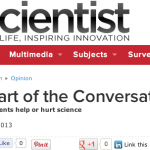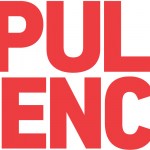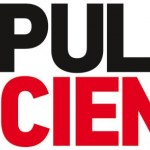Popular Science
Of all the modalities of alternative medicine currently in use, arguably acupuncture is the one that has achieved the most mainstream acceptance in medicine. I've often asked why it has become so common in academic medical centers and elsewhere, despite the evidence being overwhelmingly in favor of the conclusion that it is nothing more than a theatrical placebo. It doesn't matter that acupuncture is part of a prescientific system of medicine now known as traditional Chinese medicine (TCM), whose concepts are rooted in vitalism. It doesn't matter that what has passed for acupuncture since the…
Popular Science magazine -- one of the leading sources of news in technology, science, gadgets, space, green tech and more -- is returning as a key Media Partner with the Festival, bringing to the event not only a vast array of science media expertise, but also a special surprise: famed DIYer-at-large and zombie hunter, Chris Hackett, who is a contributing editor of Popular Science and who also hosted the Science Channel's avant garde DIY show, "Stuck With Hackett"!
Popular Science has been a major source of science and technology news since this award…
Popular Science, one of the longest running and, well, popular, magazines that deals with science has a website. Last Tuesday, on-line editor Suzanne LaBarre announced that Popular Science would no longer have comment sections on most of its pages. The reason sited was that "Comments can be bad for science." She noted:
A politically motivated, decades-long war on expertise has eroded the popular consensus on a wide variety of scientifically validated topics. Everything, from evolution to the origins of climate change, is mistakenly up for grabs again. Scientific certainty is just another…
Popular Science, one of the leading sources of news in technology, science, gadgets, space, green tech and more, is returning as a key Americium Media Partner with the Festival!
In doing so, Popular Science joins a growing list of other top science media leaders who will be serving as Festival sponsors, including Scientific American, American Scientist, Sigma Xi, ENGINEERING.com, Forbes Wolfe, and PBS Kids, among many others.
Popular Science has been a major source of science and technology news since its award-winning magazine was founded back in 1872. Its online version,…
Known as "the authority on the future of technology " and the world's oldest technology magazine,Technology Review - published by the Massachusetts Institute of Technology (MIT) - is bringing its prestige and expertise back to the Festival as a Media Partner!
Technology Review, published by MIT since 1899, continues today to provide unparalleled insights into cutting edge technologies that are changing the world and the way science and engineering do business.
In returning as a Media Partner, the magazine joins a growing list of other top science media leaders who are also serving as Festival…
Popular Science, one of the leading sources of news in technology, science, gadgets, space, green tech and more, is returning as a key Media Partner with the Festival!
In doing so, PopSci joins a growing list of other top science media leaders who will be serving as Festival sponsors, including Popular Mechanics, Scientific American, MIT's Technology Review, Chemical & Engineering News, School Tube.com, ENGINEERING.com, EE Times and PBS Kids.
PopSci has been a major source of science and technology news since its award-winning magazine Popular Science was founded back in 1872. Its online…
Now that the details about Australopithecus sediba have been published, I am faced with an important question - how am I going to fit the new hominin into Written in Stone?
When I started composing Written in Stone I was determined to make it as up-to-date as possible. This was not only out of a concern for accuracy, but also stemmed from a desire to present the public with some discoveries that they may not have heard about before. Given that new paleontological papers are being published every week, however, I have often been faced with the question of how to incorporate interesting new…
Last Friday I posted an open-thread in an attempt to gauge what readers might be getting from the "So you want to write a pop-sci book" series (Parts 1, 2, and 3), and I was quite pleased by the response. I was glad to hear so many of you have found it useful (or intend to go back to it when you get your own book projects in order). There were also a few questions about the book-writing process, and I will answer them here.
Most of the questions were asked by Stan, and I'll go through them one at a time.
"How did you solve the balance between themes that you personally found interesting,…
Earlier this week I discussed how to find a publisher for your book and how blogs can be useful tools in that process, but what about the effort that goes into completing a manuscript?
As Michael has pointed out in his latest blog-length contribution to our conversation, every writer is different. How Michael approached writing Sand was very different from how I went about composing Written in Stone, so rather than try to lay out a precise set of writing rules I will attempt to summarize my unique writing experience.
By the time I signed with Bellevue Literary Press in the autumn of 2009…
Writing a popular science book has simultaneously been the most challenging and rewarding experience of my writing career so far. It was not so much something that I wanted to do as a task that I needed to do, and without that sense of resolve Written in Stone would probably be a half-finished manuscript left to rot on my hard drive. While hard-headed persistence has been essential to writing my book, though, it was not the only thing I required, and through this blog conversation with David Williams (author of Stories in Stone; blog) and Michael Welland (author of Sand; blog) I hope to…
Long week, quick news:
Tiatia in Russia erupting in an undated photo.
The latest USGS/Smithsonian Institution
_blank">Weekly Volcano Activity Report is up. One interesting bit in the report is a thermal anomaly at
_blank">Tiatia in Russia (just north of Japan in the Kuril Islands) - a volcano for which I am unfamiliar. However, it sounds great according to the
_blank">GVP: "Tiatia volcano, one of the most impressive of the Kuril Islands, consists of a beautifully symmetrical cone that rises above the broad rim of an erosionally furrowed, 2.1 x 2.4 km wide caldera. The volcano…
Dangerous concept; successful execution: From the mediea team at Small Mammal, a cute video story that deconstructs a cute YouTube video to look at the science of cuteness.
Somebody run tell Liz Spikol!
var gaJsHost = (("https:" == document.location.protocol) ? "https://ssl." : "http://www.");
document.write(unescape("%3Cscript src='" + gaJsHost + "google-analytics.com/ga.js' type='text/javascript'%3E%3C/script%3E"));
try {
var pageTracker = _gat._getTracker("UA-3733673-3");
pageTracker._trackPageview();
} catch(err) {}



